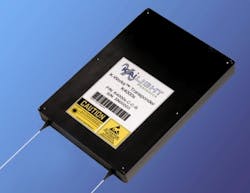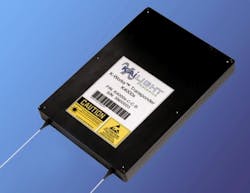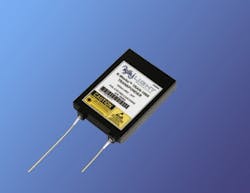Kailight Photonics touts 40G transponders at OFC/NFOEC
MARCH 22, 2007 By Meghan Fuller -- Kailight Photonics (search for Kailight Photonics) is looking to make a big splash at next week's OFC/NFOEC Conference with its K-Works family of 40-Gbit/sec transponders.
Kailight will be showing the TRAN-4800, a 40-Gbit/sec differential phase-shift keying (search for DPSK) transponder, and the TRAN-4200, a short-reach 40-Gbit/sec transponder the complements the company's previously announced TRAN-4400, which also will be highlight at the show. All of the devices are available in standard 300-pin MSA packaging, which executive vice president Neil Salisbury cites as a key strength of the company's K-Works transponder portfolio.
"Most of the solutions that are available for 40G right now are board-based solutions," he reports. "They are not in standard MSA packaging, and they also are very costly. We have a standard 300-pin MSA package for all of our solutions, and they are very cost effective."
Moreover, he says, customers who standardize on the Kailight portfolio will have the option of using any of three different 40-Gbit/sec transponders that all fit in the same form factor, enabling them to build one board around three different products.
Kailight's 40-Gbit/sec TRAN-4200 transponder uses Non-Return to Zero (search for NRZ) modulation, specified for 2-km transmission over standard singlemode fiber spans. The OIF SFI-5-compliant device targets client side networking applications.
"One of the things that is unique about the 4200, in addition to the fact that it fits into the same Kailight family of products, is that it will be the first NRZ short-reach solution that offers more than just the 39.8-Gbit/sec standard," Salisbury explains. "Our chipset allows us to go up to 43.1 Gbits/sec, which allows you to support OTU-3 as part of the G.709 standard and other FEC [forward error correction] applications that you can't get today with your standard NRZ 40-Gbit transponders."
The industry has already taken notice, says Salisbury. Beta versions of both the TRAN-4200 and the previously announced TRAN-4400, which supports duobinary (search for duobinary) modulation for long-reach applications, are currently in trials with several major systems vendors. In fact, he says, "We are already taking purchase orders. We received our first one and have three or four more on the way."
Salisbury confirms that he has an order from the U.S. and is expecting an order from Europe shortly. He says he has received RFQs from the U.S., Europe, and Asia, and he expects the first Asian trial of Kailight's 40-Gbit/sec transponders to begin soon.
Kailight will also use OFC/NFOEC to introduce its 40-Gbit/sec DPSK transponder, the K-Works TRAN-4800. According to the company, it is the first commercially available 40-Gbit/sec transponder that supports DPSK modulation in a 300-pin MSA package. Designed for long haul applications, the TRAN-4800 provides wavelength tunability over either the Extended C band or the L band. The device supports OC-768, STM-256, and OTU-3 and is OIF SFI-5 compliant. Beta samples will be available in the third quarter of this year.
Also on the roadmap for later this year, Kailight will announce a 40-Gbit/sec optical duobinary transponder that features polarization mode dispersion (search for PMD) mitigation. Like the TRAN-4400, the new transponder, dubbed the TRAN-4410, will target metro/regional networks, which is "where we believe the majority of the market is going to be for 40G," notes Salisbury.
He says a number of carriers he has spoken with are concerned about distance limitations imposed by PMD. "We predict that about 20% of spans are limited by PMD," he says, "and the 4410 will address those applications."
The advantages of 40G
For his part, Salisbury is bullish that 40G is happening now. And despite the recent groundswell of support for 100-Gigabit Ethernet, he maintains that 40G will play a significant role in the market for the foreseeable future.
"The advantage to 40 Gbits is that it overlays and can overlay with the 10-Gbit network today very nicely without having to change out fiber and without necessarily having to change out equipment, just adding new line cards to existing equipment," he says. "When you go to 100 Gbits, I don't believe you're going to get that same type of overlay; it's a brand new, Greenfield-type architecture."
Moreover, he says, once component vendors begin to integrate 40-Gbit/sec components into standard packages, like the 300-pin MSA, 40G will become more economical.
"In talking with our potential customers, the forecast we've seen is that the market is there for 40G," he adds. "100G is more than just, 'Oh, well, we're going to skip 40 and go to 100.' That sounds nice on paper, but it doesn't work once you start trying to do long-reach applications because they haven't looked at the economics of what it's going to take to implement that type of network," he contends. "One of the big factors is you don't want to have to go and pull up existing fiber."
Salisbury says that Kailight's 40G story is resonating so well with system vendors and their carrier customers that his company has to "ramp up in a big hurry on this. [Current] orders are from major system vendors. They have a need for it today, they have customers that are waiting for it, and I think we've hit the market with the right price, functionality, and features for this to really take off."
Kailight Photonics will showcase its new K-Works transponders next week at the OFC/NFOEC 2007 Conference (Booth #3357) in Anaheim, CA.
Visit Kailight Photonics

